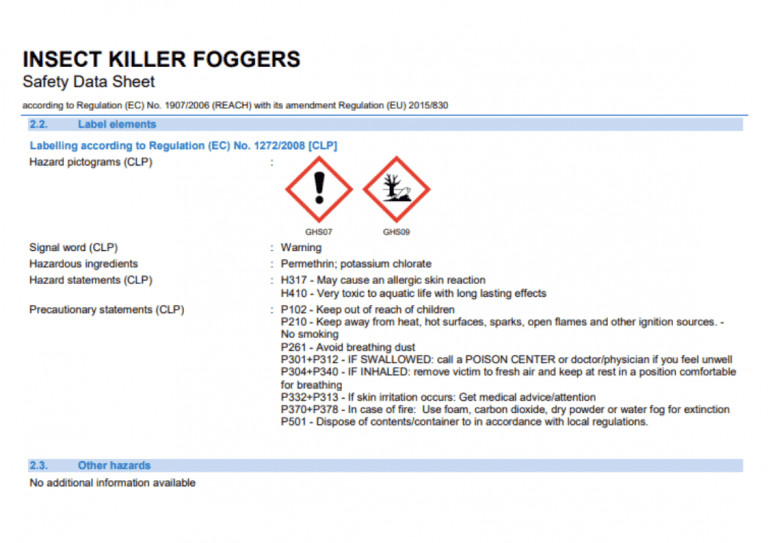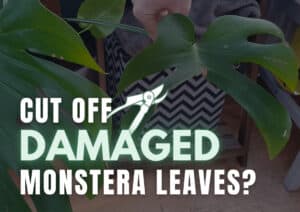Do Flea Bombs Kill Houseplants? (Fatal Flea Fogger?)
-
Chris Dosser
- January 22, 2022
If you buy something using the retail links in our articles, sometimes we earn a small affiliate commission. This does not impact the products we recommend.
Flea bombs produce a cloud of insecticide that covers all surfaces in the room where they are deployed.
With the release of chemicals strong enough to extinguish the lives of little critters it’s natural to be concerned about whether the insecticides will also harm your houseplants.
Though the insecticides released by a flea bomb pose a definitive threat to humans and animals, indoor plants will remain unaffected. As a matter of fact, the two most common chemicals found in flea bombs – Pyrethrins and Piperonyl butoxide – are registered with the EPA as safe to be used on or around houseplants.
The National Pesticide Information Center, a co-operative venture between Oregon State University and the Environmental Protection Agency, also report that in the presence of sunlight, a key component of pyrethrins breaks down rapidly (half life of 12.9hrs) on plant surfaces and in soils.
Despite clarification from the NPIC it’s clear there are still lots of conflicting opinions and advice when it comes to whether flea bombs can kill houseplants.
Some product labels of bug bombs themselves explicitly state warnings to clear people, plants and animals from the area to be treated, whilst others containing exactly the same ingredients show no warnings to plant life at all.
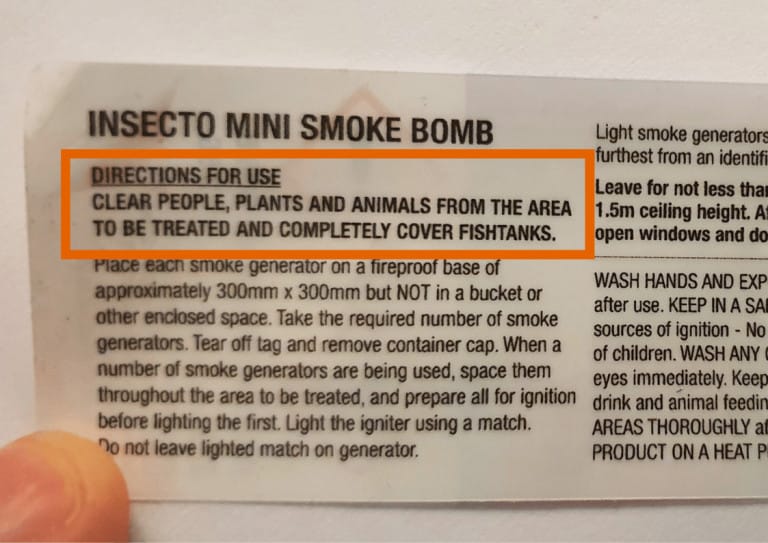
To clear up any confusion, we decided to conduct an experiment of our own in which a glasshouse full of houseplants was exposed to a flea bomb containing Permethrin 13.35% w/w and Potassium chlorate.
This article covers the results of that experiment, some facts about bug bombs and which flea bombs are actually plant safe.
Whilst being concerned about the health of houseplants may seem trivial matter, it really is worthwhile looking after your leafy companions, as they’ve been demonstrated to look after you; check out these to anti-anxiety and productivity benefits your indoor plants provide.
Do the chemicals in bug bombs kill houseplants?
Flea bombs, also known as bug bombs or fumigation foggers, can be used to treat a variety of common household pests, from pesky mosquitos to ferocious fleas. The active ingredients in all of these products will broadly be the same whether you are tackling one insect or another – pyrethrins and piperonyl butoxide (PBO).
Pyrethrins and PBOs are both registered with the U.S. Environmental Protection Agency (EPA) for use in flea bombs and are also commonly found in sprays used to control insect infestations on houseplants. These are the same ingredients found in smoke bombs marketed for use within grow houses and so are considered safe for use around terrestrial plants.
Backing this statement up, the Safety Data Sheet of Retokil’s Insect Killer Fogger, one of the most widely applied pest control products in the world, makes no mention of a warning to terrestrial plant life.
Pyrethrins
Pyrethrins can be naturally derived from chrysanthemums, a member of the daisy family, or synthetically produced.
Within a bug bomb they act as the ingredient with lethal properties. Pyrethrins work by preventing the closure of sodium channels that then has a knock on effect of preventing nerves from repolarizing. This causes paralyzation in an organism.
Man-made pyrethrins, generically classified as pyrethroids, have different names depending on the manufacturing company responsible for their creation, and are designed with the intention to kill or prevent insects from reproducing.
One such example of a pyrethroid is tetramethrin which is used to combat infestations of hornets, wasps, roaches, fleas, ants, and mosquitos by attacking their nervous system.
Piperonyl butoxide
The U.S. Environmental Protection Agency (EPA) has piperonyl butoxide (PBO) listed as a synergist. That means that PBO has no pesticide properties on its own but can enhance the pesticide effects of other active components, such as pyrethrins.
This is why you will commonly find PBO listed on the ingredient list of a flea bomb with another insect-killing ingredient. Combining a synergist and another ingredient with pesticidal effects results in a long-lasting, practical pest treatment.
Delivery of the pyrethrins/pyrethroids and PBOs is either via an aerosol or a smoke bomb fuelled by potassium chlorate.
The glasshouse experiment
To demonstrate the impact of flea bombs on houseplants we selected eight houseplants from our collection, each with different leaf textures and leaf shapes, and smoked them with a flea bomb containing permethrin 13.35% w/w + potassium chlorate designed to clear a floor space of 120m2.
The ‘lucky’ plants chosen to be fogged were:
- 2x Snake plants (Dracaena trifasciata)
- 2x Peace lillies (Spathiphyllum)
- 2x Prayer plants (Maranta leuconeura)
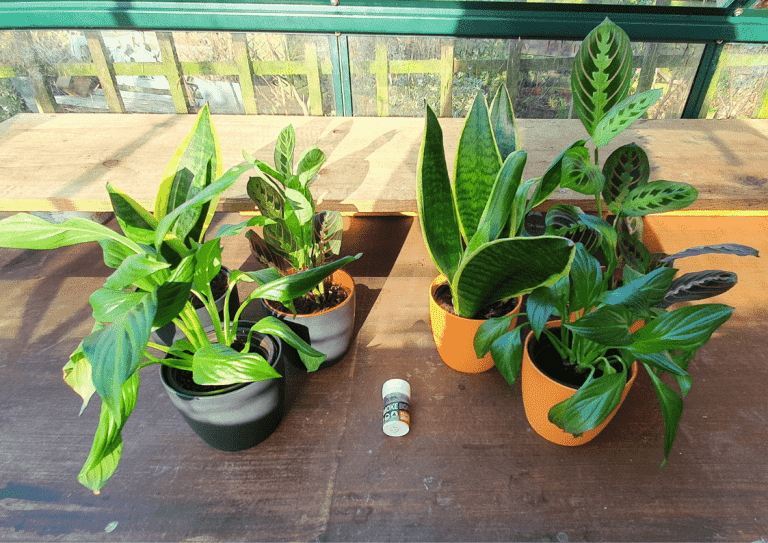
The test was conducted in two small areas to deliberately over expose the plants to doses of insecticide exuded by the flea bomb. The test zones were…
- a glasshouse with a volume of 9m3
- a sealed plastic container with a volume of 0.145m3
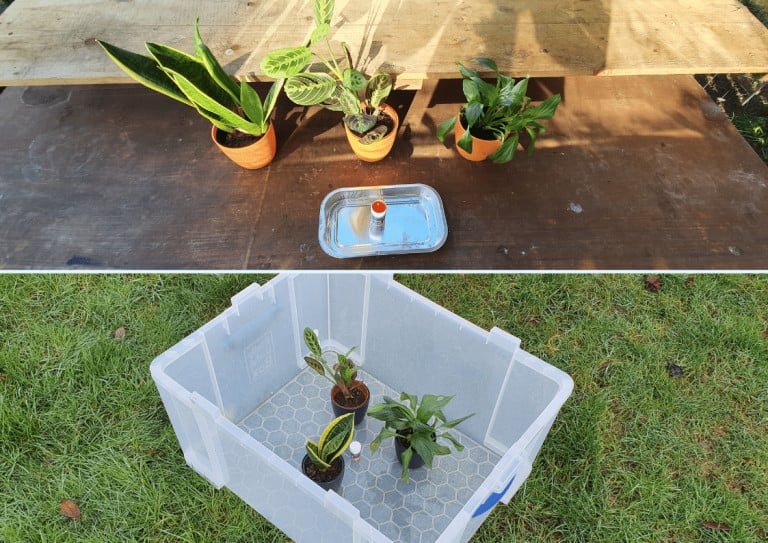
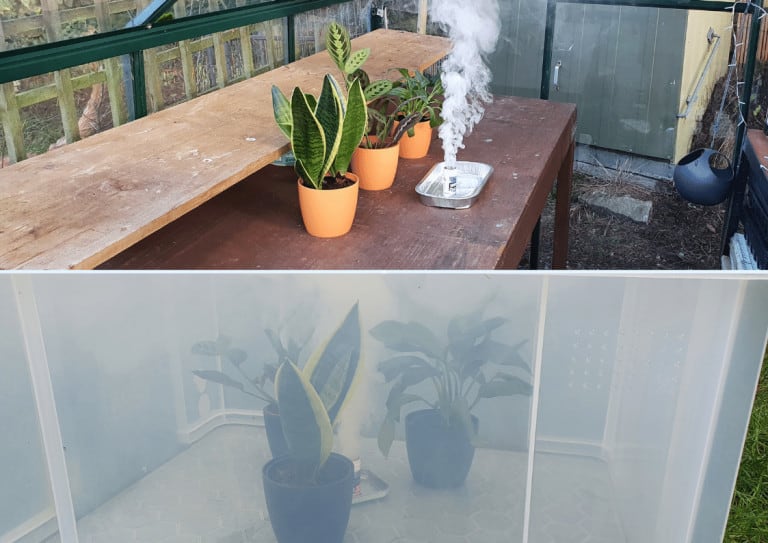
6 hours after the smoke bomb had dispersed its chemicals and it was safe to do so the plants were inspected before being moved back into their original positions indoors.
Surprisingly despite the exposure to dense clouds of chemical fog, no powdery residue was present on all foliage and soil surface.
Even for broadleaved foliage such as the peace lily it wasn’t necessary to wipe the leaves clean to allow respiration to take place as normal.
And then we waited.
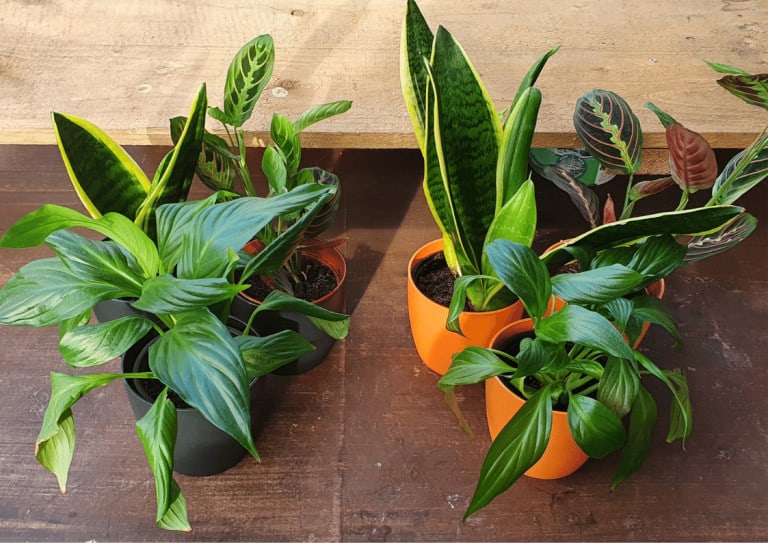
One week after being exposed to the insecticides present in the flea bomb, all of our houseplants showed zero ill effects, and continued to look as healthy as before.
There was no discernible difference between the plants that were exposed to the higher concentration of insecticide in the sealed plastic container.
Drawing upon the outcome of this experiment we can confirm that flea bombs containing permethrin + potassium chloride do not kill houseplants.
Are there natural bug bombs which are safe for houseplants?
Although the EPA registers pyrethroids and PBOs as safe for use on or around houseplants, you might still be a little wary of exposing your leafy, positivity-boosting friends to man-made chemicals. The good news for you is that there are plenty of natural alternatives.
Many natural pesticide manufacturers pride themselves on offering to rid your home or offices of pests without filling the room with toxic fumes.
Opt for bug sprays or flea bombs made of natural ingredients, like peppermint oil, clove, cottonseed oil, or natural pyrethrins. There are many natural insecticides and pesticides on the market for you to select from.
By choosing the natural route for pest control, you can rest assured that you, your family, your pets, and your plants are safe and sound (plus, many of the natural pest control methods smell fantastic).
How to temporarily relocate your houseplants during fumigation
Though flea bombs are safe for the vast majority of houseplants, you may still feel as though you shouldn’t expose your leafy brethren to toxic chemicals.
Regardless of the reason, if you would rather move your plants than have them coated in flea bombs, there’s an easy way to do so to ensure the safety and well-being of your plants before, during, and after releasing a flea bomb.
Choose an appropriate carrying container for your houseplants. You can place multiple smaller plants within cardboard boxes, putting them close to one another to avoid tipping during transportation. It is wise to move larger plants by hand or with the aid of a dolly.
Find a safe, temperature-controlled environment to safely store your houseplants while your home or office is fumigated.
Once your home has been fogged, it is best to air out your office or home by opening windows for thirty minutes to one hour.
After your space has been properly aired out and the temperature has been brought back to an ambient level, place your houseplants in their initial positions to guarantee they can get back to living their best lives.
Final thoughts
Indoor pests are utterly unavoidable, especially when you have traffic throughout your office or pets in your home. Unless you enjoy playing hotel to invasive nuisances such as fleas, it is best to take action the moment you realize that there is a problem. Infestations are absolutely no fun for anyone.
Taking the correct steps to thwart off the uninvited intruders to your space can take a few different shapes, but the most common manner of pest control is using flea bombs or fumigation foggers.
Don’t fret over the health and well-being of your houseplants, however. The EPA has registered the common chemicals found in flea bombs as safe to be used around your houseplants.
If you are still wary of the impact that a flea bomb may have on your beloved plants, you can opt to safely move your plants from the affected space or use a naturally derived pest spray.

Chris Dosser
Co-Founder of Eden Indoors
Chris is a self-taught horticulturist with over a decade of experience caring for houseplants and creating lush, thriving indoor oases. He specializes in Monstera, and by self admission has a serious problem with buying and propagating rare indoor plants!
Similar Posts
Do Houseplants Help Boost Productivity?
From improved air-quality, to increased productivity at work, houseplants have the ability to improve our working days in multiple ways.
Should I Cut Off Damaged Monstera Leaves?
Damaged Monstera leaves can ring alarm bells for plant owners. Should you cut them off, or will that do more harm than good to the plant?

